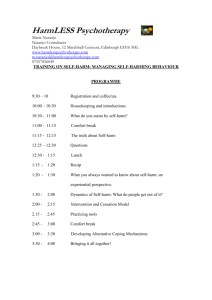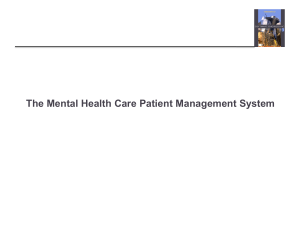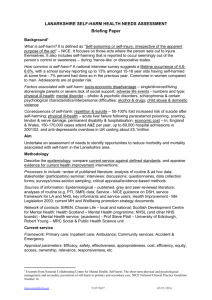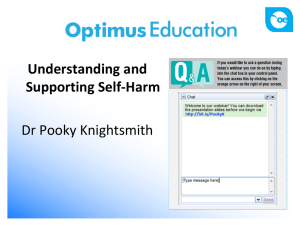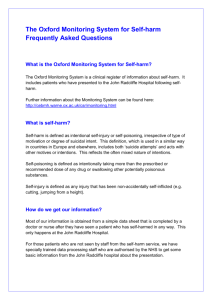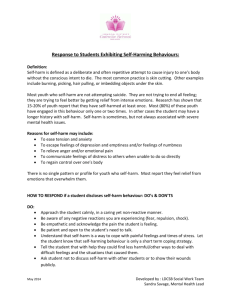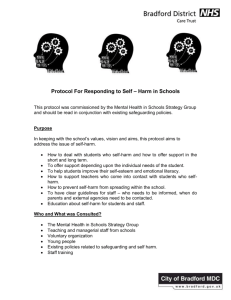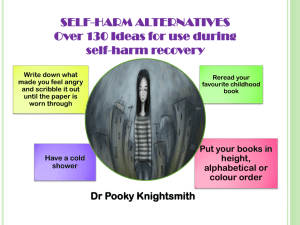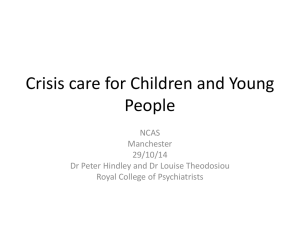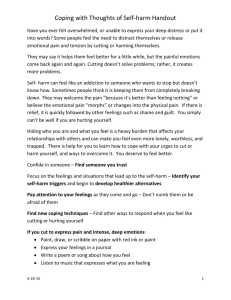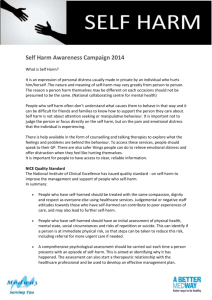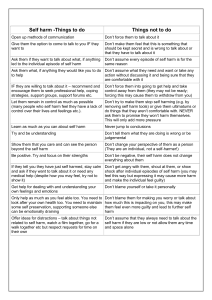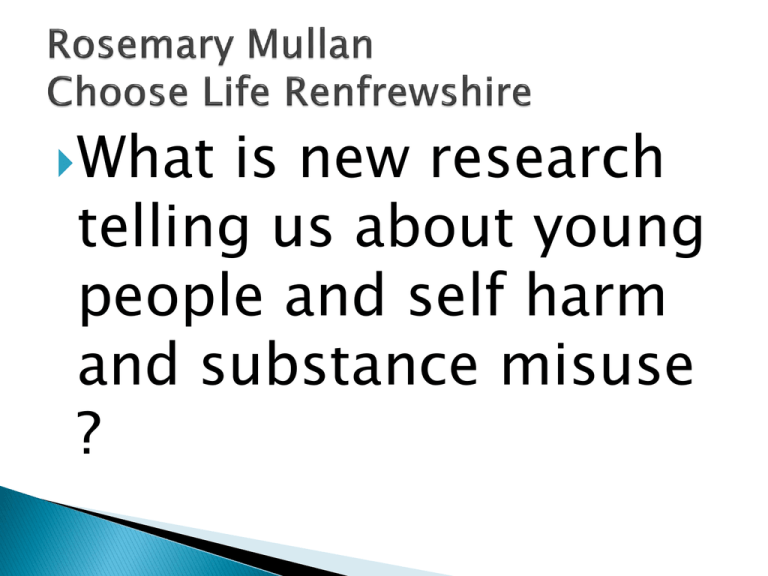
What
is new research
telling us about young
people and self harm
and substance misuse
?
Social
Aspects of
Self-Harm,
including drug
and alcohol
use 2013-14
What
does
this tell us
about
responding
to young
people who
self harm
A sociological study of how young people aged
14-16 talk about self-harm, drug and alcohol use.
An exploration of the role of social context in
shaping how self-harm, drug and alcohol use are
talked about by:
◦ Groups of young people, who may not have self-harmed
◦ Individual young people who have self-harmed
◦ Girls (probably) more likely to harm
themselves than boys
◦ Boys more likely to misuse
drugs/alcohol
◦ People from poorer
areas/backgrounds are more likely to
experience harm/death from selfharm, drugs and alcohol in adulthood
Focus groups – Scotland
Online survey – UK, US,
elsewhere
Interviews - UK
8 survey
participants who
gave no age, or
an age between
19-26
Grand total =
122 participants
Method
Number of participants
Focus group
33
Interviews
6
Online survey
88
Aged 16 and under
106
Total
122 (5 interviewees also took part
in survey)
Y axis = percentage of participants reporting type of self-harm
Dealing with emotions
Communicating about emotions
Response to
social/interpersonal problems
Response to or part of mental
ill-health
Upset
Numbness,
emptiness
Rush
Distraction
Feel something
Anger,
frustration
Calm down
Release
Depression,
sadness
Feel better
Feel happy
Rates of concurrent self harm, drug and
alcohol use are significant.
Adults who have problems with self harm
are more likely to have had substance
misuse issues as teens
Both behaviours used as coping
mechanisms
“it makes me less anxious” Helen, 16
“to not think about my demons. To not feel the
pain” Jane, 15
“to make myself feel better and be happy”
Marissa, 16
“[self-harm] releases endorphins. It's worse than a
drug” AJ, 14
“It release endorphins and you like the buzz”
Darcy, 14
“I intended on having fun so I assumed what's
better than alcohol” Dean, 15
“Drug and alcohol use is usually public knowledge
as it occurs around friends” AJ, 14
“People see those who self-harm as attention
seekers, and 'crazy‘” Sarah, 15
1.
2.
3.
4.
5.
You use alcohol and drugs
in groups
Drugs and alcohol are
costly
Alcohol is socially
acceptable
drugs and alcohol are
more hidden, they hurt
the inside of your body
Harm associated with
substance misuse may be
greater eg more likely to
have unprotected sex
1.
2.
3.
4.
self-harm is mostly
done when you are on
your own.
Self-harm is free
self-harm is not
socially acceptable
Self-harm hurts the
outside of your body
and can leave longlasting marks
“I listened to music, took a bunch of shots and cut a
bunch. My friend showed up and insisted I stop
drinking”
Why was it a bad experience?
“I'm not sure that at the time I felt it was a bad
experience, but it opened me up to cutting with
razors. Prior to this, I had only scratched with safety
pins and the like”
Ruth, no age given
“I was very drunk and I cut myself very badly. Loss of
blood was not enjoyable” Richard, 16
“if I drink it becomes ten, twenty, a hundred times
harder to resist the urge- that's happened a few
times” Jay, 16
Bottom line = needs to be
consideration of how individuals view
the relationship between self-harm,
drug and alcohol use, understanding
that alcohol use may exacerbate selfharming and affect individual’s
ability to care for themselves. But
also that others might see
alcohol/drug use as a way of
avoiding self-harm.
‘Looking at self-harm in
isolation from e.g. drug and
alcohol use is probably not a
great idea. Likely to be some
overlaps in terms of reasons,
meanings etc. Exploring these
with young people may help
them to identify their own
reasons, meanings and
Self-harm has diverse meanings for young people
– some of these are difficult to hear.
Young people who self-harm may do so in many
ways aside from cutting.
There are numerous overlaps between self-harm,
drug and alcohol use in terms of what they mean
and how they are used.
Young people who self-harm and use drugs and
alcohol may need extra support to stay safe.

